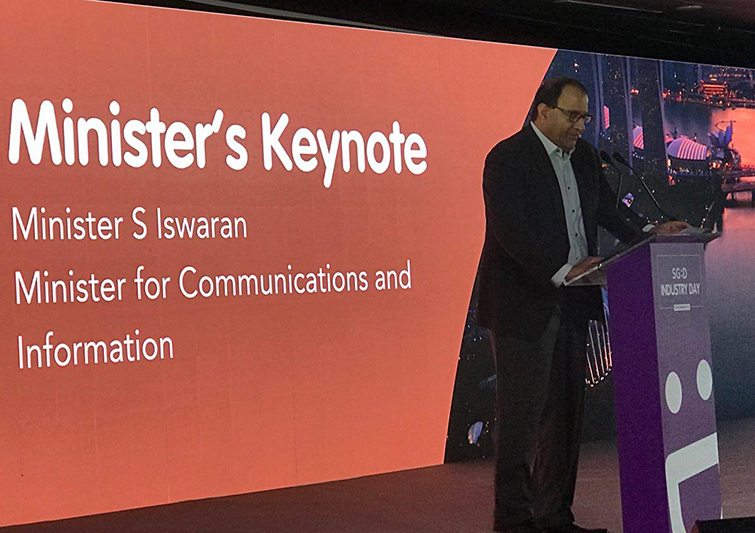Singapore Technology Roadmap identifies Services 4.0 as the future of services
By Digital News Asia November 23, 2018
- Claims next-generation services to be frictionless, empathic and anticipatory
- Cloud Native Architecture are modular and more than just cloud services

THE Info-communications Media Development Authority (IMDA) launched a series of initiatives to support the infocomm media (ICM) sector in capturing opportunities in the future of services ecosystem, as part of its Framework for Action to develop Singapore’s digital economy.
The initiatives were announced by Minister for Communications and Information, S Iswaran (pic), at IMDA’s second SG:Digital Industry Day on Nov 22, which saw the participation of more than 1,500 participants from the ICM industry.
“Our industries have progressively embarked on their digitalisation journeys and are making the transition to the new normal of operating in a digital world. To complement this, it was important to develop a refreshed technology roadmap that identifies technological engines that will be key for Singapore’s development over the next three to five years,” said Iswaran.
Services and Digital Economy Technology Roadmap
As the services industry accounts for 72% of Singapore’s GDP and 74% of national employment, the Services and Digital Economy Technology Roadmap (SDE TRM) identified Services 4.0 as a potential engine of growth for Singapore’s digital economy with the vision of end-to-end, frictionless, empathic, and anticipatory solutions.
It aims to harness technology for workers to have more fulfilling work, enabling businesses to innovate to capture opportunities in a digital marketplace, and delivering better customer experience.
To realise the Services 4.0 vision, the TRM identified Cloud Native Architecture as the heart of the evolving ICM ecosystem, providing easier access to emerging technologies that will make it more cost-effective and scalable for companies, and help meet customers’ demands in an agile manner.
The TRM also noted that the ICM ecosystem will need to transform itself to remain relevant in the ever changing landscape. About 30 companies and associations have pledged their support for the Cloud Native Architecture by joining the pioneer batch of SG:Digital Cloud Community to promote its adoption.
“Leading business-to-consumer enterprises have already started their Services 4.0 journeys. Businesses of all sizes can benefit from the new technology shifts, and IMDA’s programmes will provide the support to help every business become a digital business”, said IMDA chief executive Tan Kiat How.
Projects and programmes to support Services 4.0
To support companies’ participation in the Services 4.0 ecosystem, as a start, IMDA has initiated three main projects namely GoCloud for ICT SMEs, PIXEL and Digital Services Laboratory (DSL).
Traditionally, ICT solutions are built on complex and inflexible software architecture. GoCloud addresses this issue and helps ICT SMEs move to Cloud Native Architecture, to enable their participation in future opportunities in Services 4.0 by equipping ICT SMEs with digital capabilities in Cloud Native, Microservices and DevOps.
In his speech, Iswaran shed some light on this area: “Cloud Native Architecture is not just about shifting a company’s on-premise resources onto Cloud. More fundamentally, Cloud Native Architecture is a way to build and run applications on the cloud with flexible modular components, allowing companies to amend their applications quickly, and to scale up or down as required.”
Scheduled for roll-out in early 2019, GoCloud will enable SMEs to unlock benefits of cloud computing and rapid software delivery, create services that are more flexible, scalable and adaptable, and significantly reduce their time to market.
As for PIXEL, it was launched in 2016 to grow the innovation community through tech and media facilities. PIXEL has identified four new capabilities to support digital innovation for Services 4.0 – Design Thinking, User Interface or User Experience, Immersive Experiences and Digital Storytelling.
These capabilities will be made available to the industry through regular workshops and masterclasses, as well as mentors and coaches for innovation projects. An Immersive Experiences Lab and User Testing Lab will also be available to facilitate experimentation and testing of digital experiences.
The DSL brings together research communities, ICM players and end-users to co-architect and engineer solutions across multiple technology domains right from early-stage to deployment. Mainly comprising engineering and technical talent, the DSL seeks to address industry digitalisation challenges and national strategic interest areas which could benefit from faster intermediation.
Related Stories :


